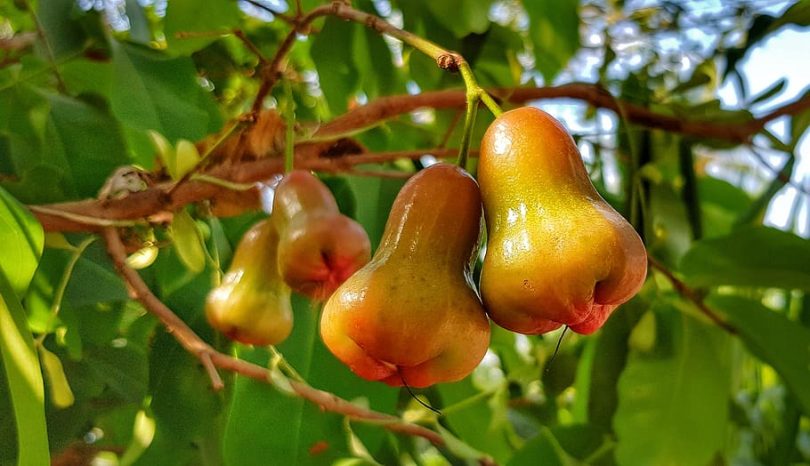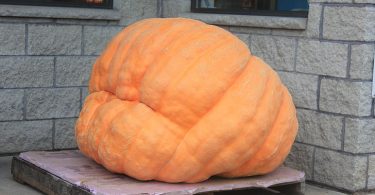Description
The rose apple tree may be merely a shrub but is generally a tree reaching 25 or even 40 ft (7.5-12 m) in height, and has a dense crown of slender, wide-spreading branches, often the overall width exceeding the height. The evergreen leaves are opposite, lanceolate or narrow-elliptic, tapering to a point; 4 to 9 in (10-22 cm) long, and from 1 to 2 1/2 in (2.5-6.25 cm) wide; somewhat leathery, glossy, dark-green when mature, rosy when young. The flowers are creamy-white or greenish-white, 2 to 4 in (5-10 cm) wide, consisting mostly of about 300 conspicuous stamens to 1 1/2 in (4 cm) long, a 4-lobed calyx, and 4 greenish-white, concave petals. There are usually 4 or 5 flowers together in terminal clusters. Capped with the prominent, green, tough calyx, the fruit is nearly round, oval, or slightly pear-shaped, 1 1/2 to 2 in (4-5 cm) long, with smooth, thin, pale-yellow or whitish skin, sometimes pink-blushed, covering a crisp, mealy, dry to juicy layer of yellowish flesh, sweet and resembling the scent of a rose in flavor. In the hollow center, there are 1 to 4 brown, rough-coated, medium-hard, more or less rounded seeds, 3/8 to 5/8 in (1-1.6 cm) thick, which loosen from the inner wall and rattle when the fruit is shaken. Fragments of the seedcoat may be found in the cavity.
Origin and Distribution
The rose apple is native to the East Indies and Malaya and is cultivated and naturalized in many parts of India, Ceylon and former Indochina and the Pacific Islands. It was introduced into Jamaica in 1762 and became well distributed in Bermuda, the Bahamas, the West Indies and, at low and medium elevations, from southern Mexico to Peru. In Guatemala, the tree may be planted as a living fencepost or in hedgerows around coffee plantations. For this purpose, it is drastically pruned to promote dense growth. It grows wild abundantly, forming solid stands and thickets, in Puerto Rico, the Virgin Islands, Guatemala, Honduras and Panama.
In 1825, eight young trees were taken from Rio de Janeiro to Hawaii by ship, and, in 1853, a United States warship delivered avocado and rose apple trees from Central America to the island of Hilo. The rose apple became naturalized on the islands of Kauai, Molokai, Oahu, Maui and Hawaii. In 1893, it was reported as already cultivated in Ghana. It is semi-naturalized in some areas of West Tropical Africa and on the islands of Zanzibar, Pemba and Reunion. It is believed to have been first planted in Queensland, Australia, about 1896. A tree obtained from an Italian nursery has grown and borne well on the coastal plain of Israel. However, it is not of interest
there as a fruit tree but rather as an ornamental.
The rose apple was introduced into Florida, at Jacksonville, before 1877, but, as a fruit tree, it is suited only to the central and southern parts of the state. In California, it is planted as far north as San Francisco for its ornamental foliage and flowers. Because the tree occupies considerable space and the fruit is little valued, the rose apple has not been planted in Florida in recent years, though there are quite a number of specimens remaining from former times.
Climate
The rose apple flourishes in the tropical and near-tropical climates only. In Jamaica, it is naturalized from near sea-level up to an altitude of 3,000 ft (915 m); in Hawaii, from sea-level to 4,000 ft (1,200 m). In India, it ranges up to 4,400 ft (1,350 m); in Ecuador, to 7,500 ft (2,300 m). At the upper limits, as in California, the tree grows vigorously but will not bear fruit.
In India, it does best on the banks of canals and streams and yet tolerates semi-arid conditions. Prolonged dry spells, however, are detrimental.
Soil
A deep, loamy soil is considered ideal for the rose apple but it is not too exacting, for it flourishes also on sand and limestone with very little organic matter.
Propagation
Most rose apple trees are grown from seeds, which are polyembryonic (producing 1 to 3 sprouts), but the seedlings are not uniform in character nor behavior. In India, vegetative propagation has been undertaken with a view to standardizing the crop and also to select and perpetuate dwarf types. Using cuttings, it was found that hardwood does not root even with chemical growth promoters. Treated semihard wood gave 20% success. Air-layers taken in the spring and treated with 1,000 ppm NAA gave 60% success. Air-layers did not root in the rainy season. In budding experiments, neither chip nor “T” buds would take. Veneer grafting in July of spring-flush scions on 1-year-old rootstocks was satisfactory in 31% of the plants. In West Bengal, air-layering is commonly performed in July and the layers are planted in October and November. Fruiting can be expected within 4 years. Sometimes the rose apple is inarched onto its own seedlings.
Culture
Rarely do rose apple trees receive any cultural attention. Some experimental work has shown that seedless, thick-fleshed fruits can be produced by treating opened flowers with growth regulators–naphthoxy acetic acid (NOA), 2,4,5-T, or naphthalene acetic acid.
Season
In Jamaica and Puerto Rico, the rose apple trees bloom and fruit sporadically nearly all year, though somewhat less in summer than at other times. The main season in the Bahamas and in Florida is May through July. The fruiting period varies in different parts of India. In South India, blooming usually occurs in January, with fruit ripening in March and April, whereas in the Circars, ripening takes place in April and May. In the central part of the country, flowering occurs in February, March and April and the fruits ripen from June through July. Then again, it is reported that there are varieties that produce fruit in February and March.






